How to Grow Sweet Potatoes: From Planting to Harvest in Your Garden
- February 28, 2024
- 0 comment
Sweet potatoes, known scientifically as Ipomoea batatas, are not only delicious but also highly nutritious, making them a favorite among gardeners and food enthusiasts alike. Rich in vitamins, fiber, and minerals, they are an excellent addition to any diet. Growing sweet potatoes is surprisingly easy and rewarding, making it a great project for both experienced and novice gardeners. This guide will walk you through the process of cultivating sweet potatoes in your own garden.
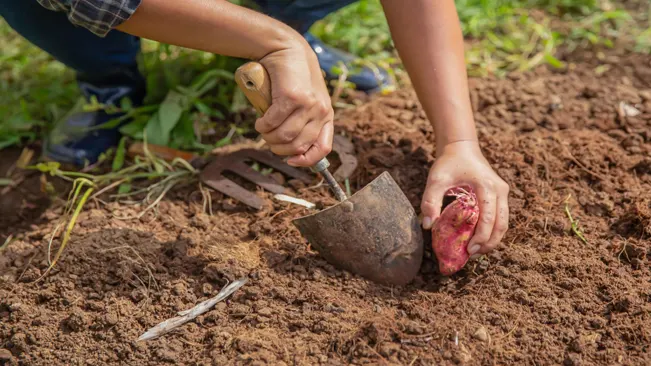
Nutritional Benefits of Sweet Potatoes
| Benefit | Description |
|---|---|
| High Nutritional Value | Sweet potatoes are rich in vitamins and minerals, including Vitamin A, C, Manganese, and Potassium. |
| Rich in Antioxidants | They contain beta-carotene, anthocyanins, and other antioxidants that help combat oxidative stress. |
| Promotes Gut Health | The high dietary fiber content supports healthy gut bacteria and improves digestion. |
| May Improve Vision | High in Vitamin A, essential for maintaining healthy vision. |
| May Boost Brain Function | Antioxidants in sweet potatoes may support brain function and reduce inflammation. |
| Supports the Immune System | Vitamin A and C in sweet potatoes are vital for a healthy immune system. |
| May Aid in Weight Management | Their high fiber content can help you feel full longer, aiding in weight control. |
| Beneficial for Blood Sugar Levels | The fiber and low glycemic index may help in regulating blood sugar levels. |
| Skin and Hair Health | Vitamins A and C are crucial for skin and hair health, promoting growth and repair. |
| Anti-inflammatory Properties | Contains compounds that may reduce inflammation in the body. |
Before diving into the cultivation process, it’s important to understand what sweet potatoes are. Unlike regular potatoes, sweet potatoes belong to the morning glory family and are a root vegetable. They are known for their sweet taste and smooth texture.
List on How To Grow Sweet Potatoes
- Choosing the Right Variety
- Preparing for Planting
- Caring for Your Sweet Potatoes
- Harvesting
- Curing and Storage
Choosing the Right Variety
There are many varieties of sweet potatoes, each with unique flavors and textures. Some popular varieties include Beauregard, Jewel, and Purple Stokes. Research the varieties that grow well in your region and suit your taste preferences.
Beauregard
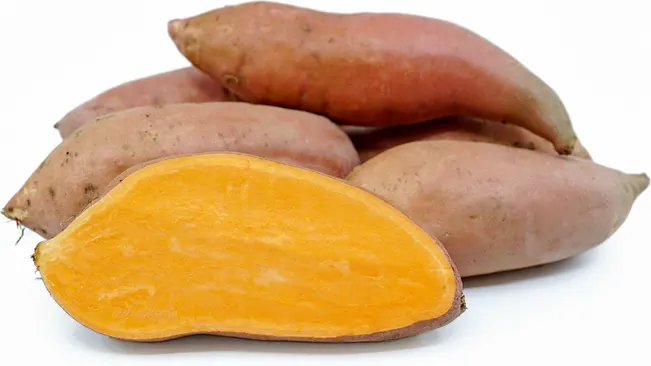
- Description: Beauregard is one of the most widely grown and commercially popular varieties in the United States.
- Characteristics: It has a purplish-red skin and sweet, orange flesh.
- Growth: It is known for its high yield and disease resistance. It matures quickly, usually in about 90 days.
- Flavor: Beauregard has a classic sweet potato flavor with a moist texture, making it versatile for cooking.
Jewel
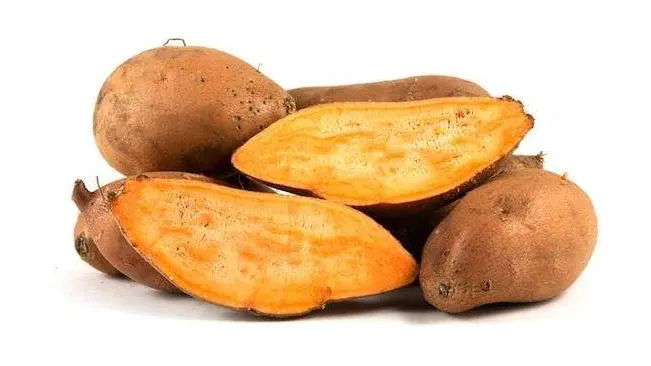
- Description: Jewel is another popular variety, often found in grocery stores.
- Characteristics: It has copper skin and deep orange flesh.
- Growth: Jewel sweet potatoes are known for their long storage life and robust plant vigor.
- Flavor: They have a mildly sweet taste and a moist, almost creamy texture.
Purple Stokes
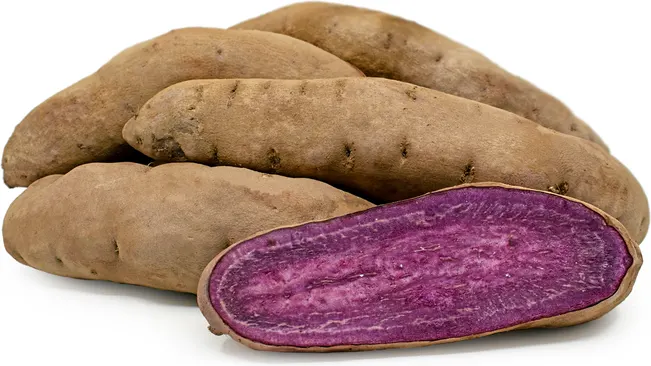
- Description: This variety is distinctive for its vibrant purple flesh, which retains its color when cooked.
- Characteristics: The Purple Stokes has a darker, more earthy skin compared to other varieties.
- Growth: While it takes a bit longer to mature (about 100-120 days), it is worth the wait for its unique color and nutritional value.
- Flavor: It’s known for its sweet, slightly nutty flavor and is richer in antioxidants due to its purple pigment.
When choosing a variety to plant, consider:
- Climate and Soil: Some varieties may be more suitable for your local climate and soil conditions. Check with local nurseries or agricultural extension services for advice.
- Purpose: Think about how you plan to use the sweet potatoes. Some varieties are better for baking, while others may be more suitable for soups or casseroles.
- Personal Taste Preferences: Ultimately, your taste preference should guide your choice. You might prefer a sweeter variety or one with a more subtle flavor.
Preparing for Planting
Sweet potatoes thrive in warm climates and require a long frost-free growing season. Here’s how you can prepare for planting:
Climate Requirements
Sweet potatoes are heat-loving plants that require a long, warm growing season to flourish. Here are key climate considerations:

- Warm Weather: They need a minimum of four months of warm, sunny weather to mature. The ideal growing temperatures are between 75°F and 95°F (24°C to 35°C).
- Frost-Free Period: Ensure that the growing period is completely frost-free. Sweet potatoes are very sensitive to cold temperatures, which can damage or kill the plants.
- Sunlight: Full sunlight is crucial. Ensure the planting area receives full sun for most of the day.
Soil Preparation
The right soil conditions are essential for the healthy growth of sweet potatoes. Consider these soil requirements:

- Soil Type: Sweet potatoes prefer light, well-drained, sandy soil. Heavy clay or dense soils can hinder root development.
- Soil pH: Aim for a soil pH between 5.5 and 6.5. Slightly acidic to neutral pH is ideal. You can test your soil’s pH using a home test kit or by sending a sample to a local extension service.
- Soil Fertility: While sweet potatoes aren’t particularly demanding, they do best in moderately fertile soil. You can amend the soil with compost or well-rotted manure to improve fertility and structure.
- Drainage: Good drainage is vital to prevent root rot. Raised beds or ridges can be very beneficial in improving soil drainage.
Space Requirements
Proper spacing is important for the growth and spread of sweet potatoes:
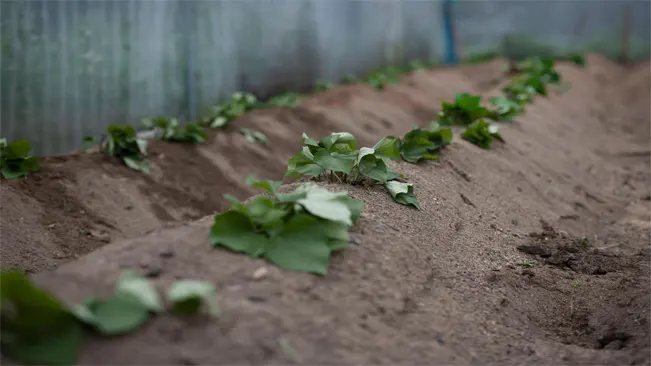
- Spacing: When planting sweet potato slips (young plants), space them about 12-18 inches apart. This spacing allows adequate room for root development.
- Row Spacing: Rows should be spaced about 3-4 feet apart. This spacing allows for easier access for maintenance and harvesting and provides enough space for the vines to spread.
- Vine Management: Sweet potato vines can spread widely. It’s important to have enough space in your garden to accommodate this growth without the plants overshadowing other nearby plants.
Planting Sweet Potatoes
Sweet potatoes are grown from slips, which are sprouts that develop from mature sweet potatoes. Here’s how to plant them:
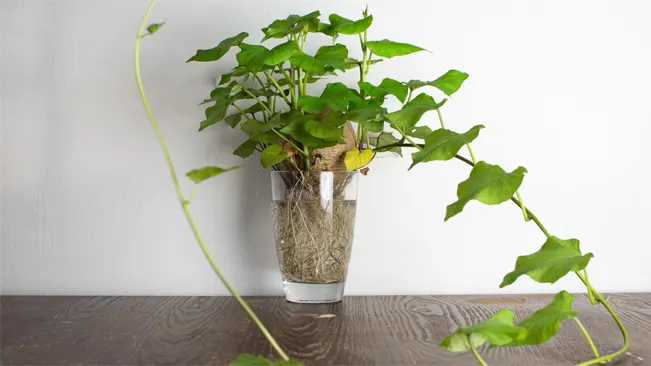
- Selecting Sweet Potatoes: Choose healthy and organic sweet potatoes for better sprouting. Organic potatoes are less likely to have been treated with sprout inhibitors.
- Sprouting Process:
- Method 1: Water Sprouting:
- Cut the sweet potato in half and suspend it using toothpicks over a glass of water, with the cut side down. The top third of the potato should be above the water.
- Place the glass in a warm, sunny window. Change the water every few days to keep it fresh.
- Method 2: Soil Sprouting:
- Bury the sweet potato in a pot with moist potting soil, leaving the top uncovered.
- Keep the soil moist and place the pot in a warm area with some sunlight.
- Method 1: Water Sprouting:
- Growth Monitoring: In both methods, sprouts (slips) will start emerging in a few weeks. Wait until they’re about 4-6 inches long.
- Removing Slips: Once the slips reach the desired length, gently twist them off the sweet potato. You can also cut them off near the base with a clean knife.
- Rooting Slips: Place the slips in a jar of water with the bottom half submerged. Place the jar in a sunny spot and wait for roots to develop. This usually takes about a week.
Planting Sweet Potato Slips
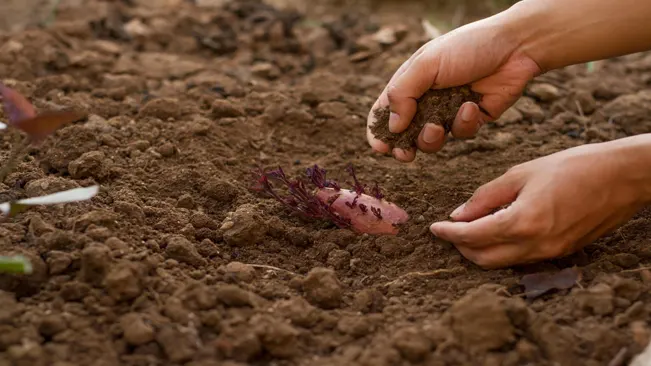
- Timing: Plant sweet potato slips after the last frost when the soil is warm. Sweet potatoes require a warm growing season of about 4 months.
- Soil Preparation:
- Choose a sunny location with well-drained soil.
- Sweet potatoes prefer slightly acidic to neutral soil (pH 5.5 to 6.5). Amend the soil with compost to ensure it’s rich and fertile.
- Consider using raised beds or ridges to improve drainage.
- Planting:
- Make holes about 4 inches deep and 12-18 inches apart in rows that are 3-4 feet apart.
- Place one slip per hole, ensuring the roots are well covered with soil. The top leaves should be just above the soil surface.
- Water the slips thoroughly after planting.
- Post-Planting Care:
- Keep the soil moist, especially during the first few weeks, to help establish the plants.
- Mulch around the plants to retain moisture, regulate soil temperature, and reduce weeds.
- Avoid over-fertilizing, particularly with nitrogen-rich fertilizers, as this can promote foliage growth at the expense of root development.
- Vine Management: Sweet potato vines can spread extensively. While not necessary, some gardeners choose to trim the vines to keep the growth in check and focus the plant’s energy on tuber formation.
Caring for Your Sweet Potatoes
Watering
Sweet potatoes require consistent moisture levels in the soil, especially during the early stages of their growth. This is crucial for the development of the roots, which will eventually become the sweet potatoes you harvest. Here’s what to keep in mind:
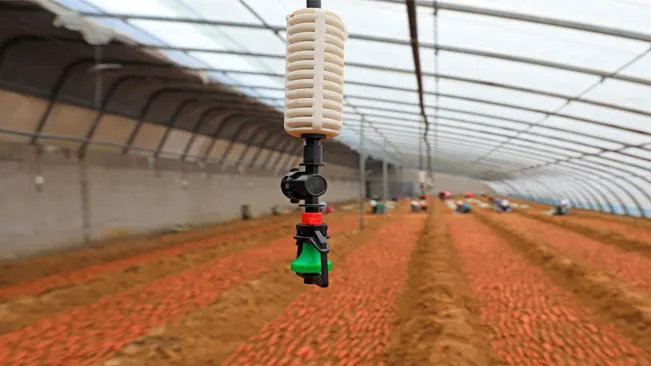
- Consistent Moisture: Water the plants regularly to maintain evenly moist soil. Avoid over-watering, as this can lead to root rot, but also ensure the soil does not dry out completely.
- Drip Irrigation: If possible, consider using a drip irrigation system. This method helps in providing a steady amount of water directly to the roots, reducing water wastage and minimizing the risk of leaf diseases.
- Mulching: Applying mulch around the plants can help retain soil moisture and regulate soil temperature.
Weeding
Weeding is essential in the cultivation of sweet potatoes for several reasons:
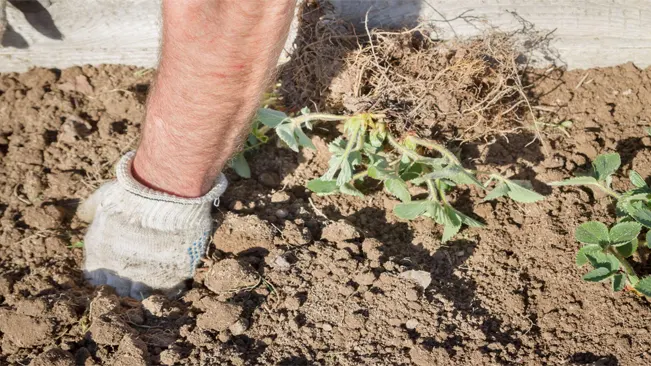
- Nutrient Competition: Weeds compete with sweet potatoes for nutrients, water, and light. Keeping the area weed-free ensures that your plants get all the resources they need.
- Disease and Pest Control: Weeds can also harbor pests and diseases that could potentially harm your sweet potatoes.
- Regular Maintenance: Regularly inspect your garden and remove weeds as soon as they appear. This is easier when the weeds are small and less established.
Fertilizing
The right fertilization is key to the successful growth of sweet potatoes. Here’s what you should consider:

- Balanced Fertilizer: Use a balanced fertilizer at planting time. Sweet potatoes benefit from a fertilizer that has equal parts of nitrogen, phosphorus, and potassium (like a 10-10-10 formula).
- Avoid High Nitrogen: High nitrogen fertilizers can promote foliage growth at the expense of root development, which is not desirable for root crops like sweet potatoes.
- Application Method: Apply the fertilizer according to the package instructions. It’s usually recommended to apply it in a band alongside the row before planting the slips.
- Soil Testing: Ideally, conduct a soil test before planting. This test will tell you exactly what nutrients your soil lacks and how to amend it for the best sweet potato growth.
Harvesting
Sweet potatoes are unique in their growing and harvesting process. Here’s a more detailed look at how to know when they are ready and how to harvest them properly:
Timing of Harvest
- 3-4 Months After Planting: Generally, sweet potatoes are ready for harvest approximately 3 to 4 months after planting. However, this can vary depending on the variety and growing conditions.
- Seasonal Considerations: In most climates, this means harvesting before the first fall frost. A frost can damage the sweet potatoes in the ground.
Identifying Harvest Readiness
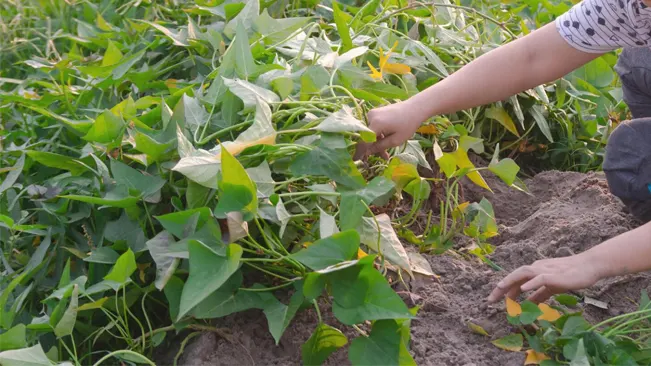
- Yellowing Leaves: As the sweet potatoes mature, the leaves of the plant will start to yellow. This is a natural indication that the tubers are nearing full development.
- Roots Protruding from Soil: You may notice the sweet potatoes pushing up through the soil surface. This exposure often indicates that the tubers have grown to a significant size.
- Skin Toughness: A mature sweet potato has tough skin that resists scratching or denting. Gently test the skin with your fingernail or a small implement; if it’s difficult to make a mark, the sweet potatoes are likely ready.
The Harvesting Process
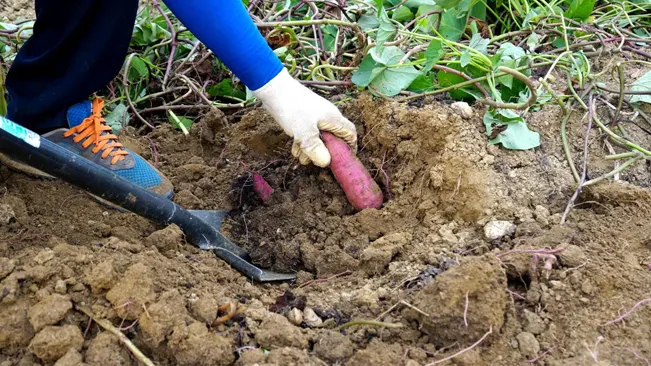
- Avoiding Damage: Use a spade or garden fork to gently dig around the sweet potato plant. Start a few inches away from where the roots protrude to avoid cutting or bruising the tubers.
- Lifting the Tubers: Carefully lift the plant from the base, shaking off any loose soil. You will find the sweet potatoes clustered around the roots.
- Gentle Handling: Sweet potatoes are prone to bruising and should be handled gently. Any cuts or bruises can lead to decay during storage.
Post-Harvest Handling

- Curing Sweet Potatoes: After harvesting, cure the sweet potatoes to improve their flavor and storage life. This involves keeping them in a warm, humid environment (about 85-90°F and 85-90% humidity) for around 10 days. Curing helps heal any minor skin damages and enhances the natural sweetness.
- Storage: Post-curing, store sweet potatoes in a cool, dark place with good ventilation. The ideal storage temperature is around 55-60°F. Do not refrigerate them, as cold temperatures can alter their taste and texture.
Common Mistakes to Avoid
- Harvesting Too Early: Harvesting sweet potatoes too early can result in smaller, less flavorful tubers.
- Damage During Harvest: Being too rough during harvesting can cause cuts and bruises, leading to spoilage.
- Skipping the Curing Process: Not curing sweet potatoes can significantly reduce their shelf life and sweetness.
Curing and Storage
Curing Sweet Potatoes
Curing is a process that helps heal any surface damage on the sweet potatoes, which occurs during harvesting. This process also enhances their natural sweetness and prepares them for storage. Here’s a more detailed look:

- Why Cure?: Curing allows the skin to toughen and the starches within the sweet potatoes to convert into sugars. This not only improves the flavor but also extends their storage life.
- Ideal Conditions for Curing:
- Temperature: The optimal temperature for curing sweet potatoes is around 80-85°F (27-29°C).
- Humidity: High humidity, around 85-90%, is crucial during the curing process. This level of humidity prevents the roots from drying out too quickly and helps in the healing of skin wounds.
- Duration: The curing process typically lasts for about 10 days. However, this can vary depending on the variety and the conditions.
- Curing Process:
- After harvesting, gently wash the sweet potatoes to remove soil, being careful not to bruise them.
- Arrange them in a single layer in a warm, humid place. A greenhouse or a shed with a humidifier can work well.
- Ensure good air circulation to prevent any fungal growth.
Storing Sweet Potatoes
After curing, sweet potatoes need to be stored properly to maintain their quality and extend their shelf life.
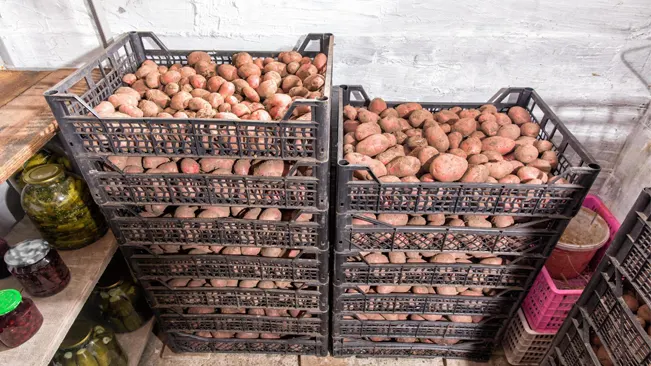
- Storage Conditions:
- Temperature: Store sweet potatoes in a cool, dark place, ideally at temperatures between 55-60°F (13-15°C).
- Humidity: Moderate humidity is preferred during storage to prevent them from drying out.
- Light: Avoid exposure to light to prevent greening and sprouting.
- Storage Tips:
- Do not refrigerate sweet potatoes before they are cured as cold temperatures can damage them.
- Store them away from other produce to prevent the ethylene gas produced by some fruits and vegetables from affecting them.
- Check periodically for any signs of spoilage or rot and remove affected sweet potatoes to prevent it from spreading.
- Shelf Life:
- When cured and stored properly, sweet potatoes can last several months. However, this can vary based on the variety and storage conditions.
Conclusion
Growing sweet potatoes can be a fun and rewarding experience. With the right conditions and care, you can enjoy a bountiful harvest of these delicious and nutritious root vegetables. Whether baked, roasted, or made into pies, sweet potatoes are a versatile addition to any meal. Happy gardening!
FAQs (Frequently Asked Questions)
- What is the best time to plant sweet potatoes?
Sweet potatoes should be planted in late spring or early summer, as they require warm soil and a long frost-free growing season. - How long do sweet potatoes take to grow?
Typically, sweet potatoes take about 90 to 120 days (3 to 4 months) to mature, depending on the variety and climate conditions. - Do sweet potatoes need full sun?
Yes, sweet potatoes thrive in full sun. They need at least 6 hours of direct sunlight daily for optimal growth. - What type of soil is best for sweet potatoes?
Sweet potatoes prefer well-drained, sandy, and fertile soil with a slightly acidic to neutral pH (5.5 to 6.5). - How much space do sweet potatoes need?
Plant sweet potato slips about 12 to 18 inches apart in rows that are 3 to 4 feet apart to give them enough space to grow. - How often should I water sweet potatoes?
Water sweet potatoes regularly to keep the soil consistently moist, especially during dry spells. However, avoid overwatering as it can lead to root rot. - Can I grow sweet potatoes from a store-bought sweet potato?
Yes, you can start slips from a store-bought sweet potato, but it’s better to use organic ones as non-organic may be treated to inhibit sprouting. - When should I harvest sweet potatoes?
Harvest sweet potatoes when the leaves start to yellow or after the first frost, typically 3 to 4 months after planting. - Do I need to cure sweet potatoes after harvesting?
Yes, curing is essential to heal any skin damage, enhance sweetness, and extend shelf life. Cure sweet potatoes in a warm, humid place for about 10 days. - How do I store sweet potatoes after curing?
Store cured sweet potatoes in a cool, dark, and well-ventilated place. Ideal storage temperatures are between 55-60°F (13-15°C).

Kristine Moore
Forestry AuthorI'm Kristine Moore, a seasoned garden landscaping professional with over 30 years of experience. My extensive career has been dedicated to transforming outdoor spaces into stunning, sustainable landscapes. With a deep understanding of horticulture, design principles, and environmental stewardship, I have become a respected figure in the field, known for creating harmonious, visually appealing, and eco-friendly gardens. My commitment to excellence and continuous learning in landscaping trends and techniques has solidified my reputation as an expert in garden design and implementation.













Leave your comment